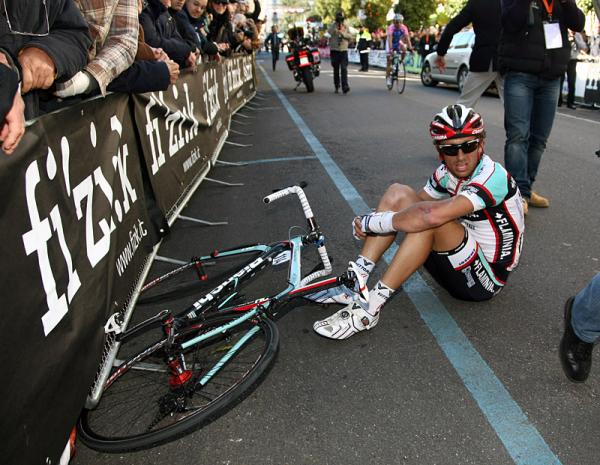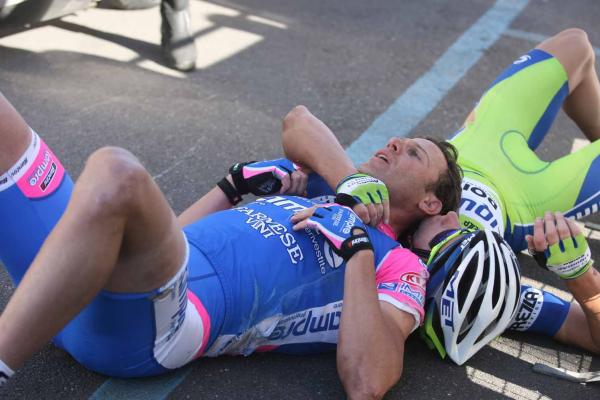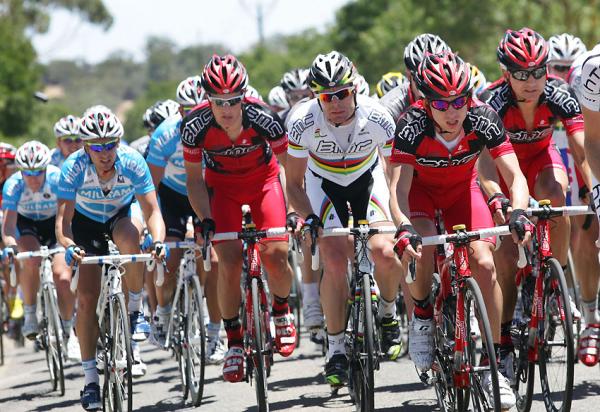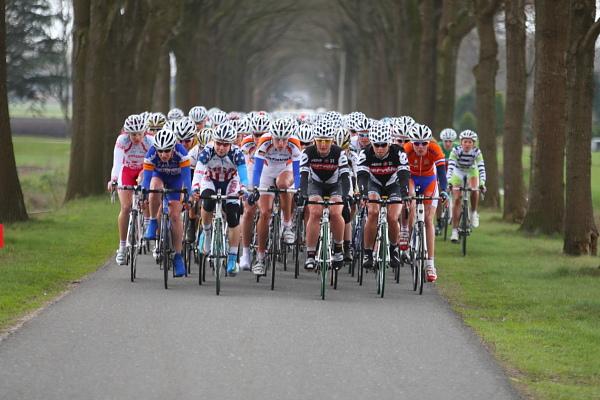Cyclingnews Fitness Q&A - April 14, 2010
Your fitness questions answered




Got a question for the fitness panel? Send it to fitness@cyclingnews.com. Emails may be edited for length or clarity, but we try to publish both questions and answers in their entirety.
Avoiding a broken collarbone
One of our club riders fell and broke his collarbone in a sprint at the end of our group ride yesterday evening.
Question part 1: This got me to thinking, are there any weight lifting activities I can do to strengthen the muscles in my shoulders that would lower the risk of this injury?
Part 2: I got a front row view immediately behind the fall; there really is zero reaction time when you go down like that. When you are falling (due to overlapping someone's rear wheel) is there anything you can do at all to lower your chance of injury?
Jason Turner
Cary, NC
Scott Saifer says
Jason,
Get The Leadout Newsletter
The latest race content, interviews, features, reviews and expert buying guides, direct to your inbox!
The short answer to your first question is no and the short answer to the second part is yes. Collarbones break usually either from landing on a straight outstretched arm or directly on the shoulder. In either case a substantial fraction of the weight of the whole body is loading that bone.
The body is going 5, 10, 15 maybe 20 miles per hour, and the shoulder or straight arm is trying to stop it in a few inches. Muscle is not going to help.
However, if you can work out how to not land on your shoulder or straight arm, you have a much better chance of not breaking a collarbone. The trick then is to develop another way of falling and practice it until it is so automatic that you will do it reflexively in a crash. I've heard of three methods being used successfully.
1) "Swedish fall" is a move borrowed from gymnastics. One falls into a push up position on bent arms and then absorbs just a bit of speed before the chest hits the ground. If you can get one leg free and throw it back just before impact, you reduce impact a little more.
I recommend practicing this one dozens of times on gym mats with no bike before doing it from a bike, and I'm not sure I can advocate practicing on the bike, since you'll probably still get hurt, just not as bad as if you hit straight arm. I know this one works because I used it several times in races and on training rides and got no injuries worse than road rash on my inner elbows.
2) Dive roll is the classic recommendation. This one you also want to practice on mats or grass. On soft enough ground, this one is really fun to practice. If you sprint into a roll you can tumble several times over and come up uninjured. Just check for sprinkler heads and dog bombs before you do it outside.
3) I saw a bike racer buddy of mine who was a former Judo champion do this one twice or I wouldn't believe it could happen: As he overlapped wheels and his bike began to get tilted over, he managed to unclip, throw the bike between his legs and land running.
There is one more thing to be aware of: even a forceful overlap doesn't have to end with a crash. If you pull the bike back hard and lean away from the overlapping wheel, you can sometimes back out of a bad situation. If you overlap long enough to start falling, first push the wheel harder into the overlap to get the bike more upright, then lean away and back out. In my district, the skills practice sessions for beginning racers actually include this drill.
Riding after a vasectomy
Hi,
I'm a 36-year-old, occasionally-competitive (but race-minded) cyclist. I average five to eight hours a week of training time plus a short daily commute to work. I've been putting in more hours and doing so more consistently than the past couple seasons have allowed, and I feel I'm finally starting to come around.
The problem: I'm about to get a vasectomy. No doubt this hiccup in training will be less intrusive than a third child, but I'm still concerned that my gains will disappear if I have to take a lot of time before I can feel comfortable in the saddle. Any advice on how best to handle this? Any anecdotal experience?
Hoping that I can limit downtime to a week - is that reasonable? I've got four weeks until 'v-day'. Thanks for any advice you can offer.
Bret
Scott Saifer says
Bret,
Ask your doctor how long to stay off the bike. Then get back to us with that information and we'll give you some advice on what to do to minimise losses and also what you can expect in terms of time back to full strength.
Kelby Bethards says
Bret,
DO NOT ride hard in that four days. You'll be sorry and you are NOT going to lose fitness.
I have warned and warned patients after doing a vasectomy on them that it won't feel too bad but do not do ANYTHING strenuous. Those that follow those instructions usually do fine. Those that do not, suffer a bit longer.
One gentleman came back, sheepishly, after not following the guidance with a scrotum that was black and blue and swollen. His complaint on the chart was 'blackened scrotum'... he wasn't referring to a cajun dish, either.
If you do not recover adequately from any illness/procedure/etc you will eventually lose more time than if you had just followed the instructions.
Bret then responded:
Dr Bethards,
Thanks for that. So you've actually performed vasectomies? Wow, the Cyclingnews fitness panel is more well-rounded than I thought! Anyway, I'm not planning to ride at all in those four days post-surgery, and I'm planning to follow Scott's advice (gradually longer base rides) after that.
While I've got you, does four days post-surgery for a bilateral vasectomy seem about right to start short, mellow rides? I'd be happy to make it six days if it will limit the risk of a bruised and swollen scrotum.
Kelby Bethards says
It seems cliche, but I will say, see how you feel. So, not all procedures go equally well and sometimes a little more time is required to mend.
If you feel good at three days, ride on the fifth day. If you just start to feel good at four days, ride on the sixth day. In essence, mend and let your intuition tell you. If you are still swollen and hurting, don't go. Simple formula.
I am a general practice trained MD, but do mostly ER now. Funny though, I am scheduled to do a vasectomy tomorrow in a clinic I still work at some.
You won't lose much ground from this. A good friend of mine had his done on a Friday and mountain biked on the following weekend (eight days later) without a problem. Mind you, it was rough mountain biking terrain, too.
Confidence riding in a pack
Hello,
I'm a competitive cyclist (amateur elite in Germany) with a few placings in local and regional criteriums and even a podium step in a time trial or two. However, it has been brought to my attention lately that my pack riding skills are way behind my current fitness level.
It seems I only manage to finish and/or place in races because of my TT skills, as I take very little advantage of pack riding. Indeed, I tend to be alright in small breakaways or in smaller packs, but when it comes to a larger peloton, I absolutely freak out if I feel like I'll be boxed in; this leads me to riding mostly on the sides (and often into the wind), or even a few bike lengths behind the pack.
After noticing this (and especially after having this brought up by some teammates), I've been trying to steadily push myself more into the middle, but eventually at some point (especially during abrupt rhythm changes and 'shuffling' inside the peloton) the bumping will drive me again, scared and shaking, to the back or to the sides.
Looking to the past, my cycling origin takes me back to southern Brazil, where most races had no more than 20 or 30 racers - so as a junior and under 23, I never really learnt big pack riding skills. In one of my first races in a 100+ field in Europe, I got boxed in in the final lap of a circuit race and went down in a mass pile up, and I believe this still influences me as I remember that crash quite vividly.
What would you recommend in this case? Is there any sort of exercise to increase confidence and still mantain a minimum amount of safety inside the peloton? Should I seek psychiatric help?
Greetings from the German springtime,
Ricardo Wickert
Scott Saifer says
Ricardo,
I hope the psychologist on the forum with jump in with some comments for you. There are a few things I recommend. One is to be sure that you are not re-imagining your crash. Imagining a bad or scary scenario is practicing fear.
Since you are already good at that, it's time to practice confidence instead. Practice riding in tight groups with your buddies. Don't just do pacelines. Practice riding between and surrounded by other riders. Practice bumping shoulder to shoulder, pushing other riders out of the way and generally protecting your space.
Practice rubbing wheels and backing out so you don't fall. If you do these sorts of things with some regularity, your sense of what it means to be in a tight pack will change from scary to ready and confident.
Carrie Cheadle says
Ricardo,
You have to work on both the physical and mental piece in order to improve your confidence riding in the pack. As you’ve seen, at some point, your inability to ride in a large peloton is going to hold you back from performing to your potential as a cyclist. You'll end up hanging off the back dealing with the rubber band effect, not be able to respond to moves as quickly, etc.
Like Scott said, the first thing is to practice, practice, practice! The first thing I always suggest to people who get nervous in the pack is to go work on your bike handling skills. Go find a couple bike handling clinics and sign up! If there aren’t any clinics around you, then create your own with some of the suggestions from Scott.
Also take advantage of group rides. Make one or two of your training days a group ride where you can get more comfortable riding in close proximity to others. What is happening now is that when you are in a pack, a piece of your brain is holding onto that image of your crash so when someone bumps you, you instantly elicit your stress response which makes you stiffen up.
That stress response makes you tighten your muscles which then impacts your balance and coordination on the bike. The result of that makes you feel squirrely and out of control which makes you feel more tense and nervous about riding in the pack!
In addition to working on your bike handling skills, you need choose ahead of time what you want to be focusing on in that situation. When you aren’t used to riding in a pack and suddenly you’re boxed in, you might be sending yourself messages like 'I don’t like this. I gotta get out of here. What if I bump someone? What if someone crashes in front of me?'
These fear-based thoughts are a part of that negative feedback loop eliciting your stress response which in turn makes your bike handling worse. Ask yourself 'What do I need to say to myself in this situation in order to feel calm and confident? Where does my focus need to be in that moment?' Choosing your response ahead of time makes it more likely that you will respond in that way.
Also remind yourself to relax. When you go out and practice, pick times to do a body scan and relax your hands and face. Cyclists tend to hold a lot of tension in those two areas and as soon as you remind yourself to relax your hands and face, you usually drop your shoulders and relax the rest of your body as well. Relax your mind and relax your body and you will feel more confident and have more control on the bike.
Weight training for pros
I'm curious about what kind of power a good bike racer can produce in the weight room. I resorted to more frequent weight training sessions the last few months (two per week) since adding another child to my family.
This time in the gym got me curious about what kind of weight the top pros put on their backs when they do a set of squats. Do any of you have inside information about what kind of weight they can lift?
Steve Sherman
North Carolina
Scott Saifer says
Steve,
What they can put on their backs and what they do put on their backs may be two entirely different questions. I don't have enough data points to say what is typical but I can share a few examples.
I know if one sprinter who won the Scandinavian road championship (amateur) whose squat routine peaked at 10 sets of 100 repetitions with somewhere around 120 pounds. One of my clients turned pro with a regional team after a winter in which he worked up to eight sets of 40 repetitions with about 150 pounds.
The Cyclingnews Form & Fitness panel
Steve Hogg (www.cyclefitcentre.com) has owned and operated Pedal Pushers since 1986, a cycle shop specialising in rider positioning and custom bicycles. In that time he has positioned riders from all cycling disciplines and of all levels of ability with every concievable cycling problem. Clients range from recreational riders and riders with disabilities to World and National champions.
Scott Saifer (www.wenzelcoaching.com) is head coach, CEO of Wenzel Coaching.com and has been coaching cyclists professionally for 18 years. He combines a master's degree in Exercise Physiology with experience in 20 years of touring and racing and over 300 road, track and MTB races to deliver training plans and advice that are both rigorously scientific and compatible with the real world of bike racing.
Scott has helped clients to turn pro as well as to win medals at US Masters National and World Championship events. He has worked with hundreds of beginning riders and racers and particularly enjoys working with the special or challenging rider. Scott is co-author of Bike Racing 101 with Kendra Wenzel and his monthly column appears in ROAD Magazine.
Kelby Bethards, MD received a Bachelor of Science in Electrical Engineering from Iowa State University (1994) before obtaining an M.D. from the University of Iowa College of Medicine in 2000. Has been a racing cyclist 'on and off' for 20 years, and when time allows, he races Cat 3 and 35+.
He is a team physician for two local Ft Collins, CO, teams, and currently works Family Practice in multiple settings: rural, urgent care, inpatient and the like.
Pam Hinton has a bachelor's degree in Molecular Biology and a doctoral degree in Nutritional Sciences, both from the University of Wisconsin-Madison.
She did postdoctoral training at Cornell University and is now an associate professor of Nutrition and Exercise Physiology at the University of Missouri-Columbia where she studies the effects of energy balance on bone health. She has published on the effects of cycling and multi-day stage racing on bone density and turnover.
Pam was an All-American in track while at the UW. She started cycling competitively in 2003 and is a three-time Missouri State Road Champion.
David Fleckenstein, MPT, OCS (www.physiopt.com) is a physical therapist practicing in Eagle, ID and the president of Physiotherapy, PA, an outpatient orthopedic clinic focusing in orthopedics, spine, and sportsmedicine care.
His clients have included World and US champions, Olympic athletes and numerous professional athletes. He received his Masters degree in Physical Therapy from Emory University and is currently completing his doctorate at Regis University.
He is a board certified orthopedic specialist focusing in manual medicine and specific retraining of spine and joint stabilisation musculature. He is a former Cat I road racer and Expert mountain biker.
Carrie Cheadle, MA (www.carriecheadle.com) is a Sports Psychology consultant who has dedicated her career to helping athletes of all ages and abilities perform to their potential. Carrie specialises in working with cyclists, in disciplines ranging from track racing to mountain biking. She holds a bachelors degree in Psychology from Sonoma State University as well as a masters degree in Sport Psychology from John F. Kennedy University.
Dave Palese (www.davepalese.com) is a USA Cycling licensed coach and masters' class road racer with 16 years' race experience. He coaches racers and riders of all abilities from his home in southern Maine, USA, where he lives with his wife Sheryl, daughter Molly, and two cats, Miranda and Mu-Mu.
Dario Fredrick (www.wholeathlete.com) is an exercise physiologist and head coach for Whole Athlete™. He is a former category 1 & semi-pro MTB racer. Dario holds a masters degree in exercise science and a bachelors in sport psychology.